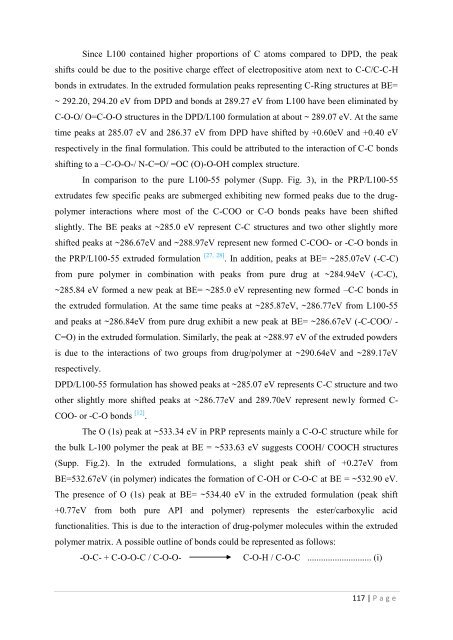Development of hot-melt extrusion as a novel technique for the ...
Development of hot-melt extrusion as a novel technique for the ...
Development of hot-melt extrusion as a novel technique for the ...
Create successful ePaper yourself
Turn your PDF publications into a flip-book with our unique Google optimized e-Paper software.
Since L100 contained higher proportions <strong>of</strong> C atoms compared to DPD, <strong>the</strong> peakshifts could be due to <strong>the</strong> positive charge effect <strong>of</strong> electropositive atom next to C-C/C-C-Hbonds in extrudates. In <strong>the</strong> extruded <strong>for</strong>mulation peaks representing C-Ring structures at BE=~ 292.20, 294.20 eV from DPD and bonds at 289.27 eV from L100 have been eliminated byC-O-O/ O=C-O-O structures in <strong>the</strong> DPD/L100 <strong>for</strong>mulation at about ~ 289.07 eV. At <strong>the</strong> sametime peaks at 285.07 eV and 286.37 eV from DPD have shifted by +0.60eV and +0.40 eVrespectively in <strong>the</strong> final <strong>for</strong>mulation. This could be attributed to <strong>the</strong> interaction <strong>of</strong> C-C bondsshifting to a –C-O-O-/ N-C=O/ =OC (O)-O-OH complex structure.In comparison to <strong>the</strong> pure L100-55 polymer (Supp. Fig. 3), in <strong>the</strong> PRP/L100-55extrudates few specific peaks are submerged exhibiting new <strong>for</strong>med peaks due to <strong>the</strong> drugpolymerinteractions where most <strong>of</strong> <strong>the</strong> C-COO or C-O bonds peaks have been shiftedslightly. The BE peaks at ~285.0 eV represent C-C structures and two o<strong>the</strong>r slightly moreshifted peaks at ~286.67eV and ~288.97eV represent new <strong>for</strong>med C-COO- or -C-O bonds in<strong>the</strong> PRP/L100-55 extruded <strong>for</strong>mulation [27, 28] . In addition, peaks at BE= ~285.07eV (-C-C)from pure polymer in combination with peaks from pure drug at ~284.94eV (-C-C),~285.84 eV <strong>for</strong>med a new peak at BE= ~285.0 eV representing new <strong>for</strong>med –C-C bonds in<strong>the</strong> extruded <strong>for</strong>mulation. At <strong>the</strong> same time peaks at ~285.87eV, ~286.77eV from L100-55and peaks at ~286.84eV from pure drug exhibit a new peak at BE= ~286.67eV (-C-COO/ -C=O) in <strong>the</strong> extruded <strong>for</strong>mulation. Similarly, <strong>the</strong> peak at ~288.97 eV <strong>of</strong> <strong>the</strong> extruded powdersis due to <strong>the</strong> interactions <strong>of</strong> two groups from drug/polymer at ~290.64eV and ~289.17eVrespectively.DPD/L100-55 <strong>for</strong>mulation h<strong>as</strong> showed peaks at ~285.07 eV represents C-C structure and twoo<strong>the</strong>r slightly more shifted peaks at ~286.77eV and 289.70eV represent newly <strong>for</strong>med C-COO- or -C-O bonds [12] .The O (1s) peak at ~533.34 eV in PRP represents mainly a C-O-C structure while <strong>for</strong><strong>the</strong> bulk L-100 polymer <strong>the</strong> peak at BE = ~533.63 eV suggests COOH/ COOCH structures(Supp. Fig.2). In <strong>the</strong> extruded <strong>for</strong>mulations, a slight peak shift <strong>of</strong> +0.27eV fromBE=532.67eV (in polymer) indicates <strong>the</strong> <strong>for</strong>mation <strong>of</strong> C-OH or C-O-C at BE = ~532.90 eV.The presence <strong>of</strong> O (1s) peak at BE= ~534.40 eV in <strong>the</strong> extruded <strong>for</strong>mulation (peak shift+0.77eV from both pure API and polymer) represents <strong>the</strong> ester/carboxylic acidfunctionalities. This is due to <strong>the</strong> interaction <strong>of</strong> drug-polymer molecules within <strong>the</strong> extrudedpolymer matrix. A possible outline <strong>of</strong> bonds could be represented <strong>as</strong> follows:-O-C- + C-O-O-C / C-O-O-C-O-H / C-O-C ............................ (i)117 | P a g e
















